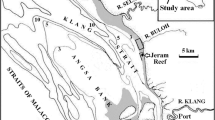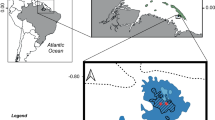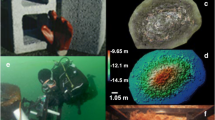Synopsis
Research on eleven artificial reefs in Puget Sound, Washington examined the relative importance of reef-produced prey items to recreationally important reef fish species assemblages. The colonization of potential prey items, and fish species assemblages to ten artificial reefs were examined for the reefs first two to five years, and observations were conducted on an eleventh reef during its forty-ninth productive year. Fish species became more abundant, or were seen more frequently on reef habitats whose substrates had successionally developed from barnalces to algal mats. Fish species most affected by this successional change foraged heavily on organisms which were associated with reef algae. Starfish and nudibranchs. who preyed on the barnacles, were identified as the ‘keystone’ predators of these subtidal reef habitats.
Similar content being viewed by others
References cited
Anderson, R.D. & K.K. Chew. 1972. Preliminary study on the transient species of fish in Big Beef Harbor. Trans. Amer. Fish. Soc. 101: 726–729.
Barker, M.W. 1979. Population and fishery dynamics of recreation exploited marine bottomfish of Northern Puget Sound. Ph.D. Dissertation, University of Washington, Seattle. 134 pp.
Bohnsack, J.A. & D.L. Sutherland. 1985. Artificial reef research: a review with recommendations for future priorities. Bull. Mar. Sci. 37: 11–39.
Bray, R.N. & A.C. Miller. 1985. Planktivorous fishes: their potential as nutrient importers to artificial reefs. Bull. Mar. Sci. 37: 396.
Brock. R.E. 1980. Colonization of marine fishes in a newly created harbor, Honokohau, Hawaii. Pacific Science 34: 313–326.
Brock, R.E., C. Lewis & R.C. Wass. 1979. Stability and structure of a fish community on a coral patch reef in Hawaii. Mar. Biol. 54: 281–292.
Brock, V.E. 1954. A preliminary report on a method of estimating reef populations. J. Wildl. Mgmt. 18: 297–308.
Buckley, R.M. 1982. Marine habitat enhancement and urban recreational fishing in Washington. Mar. Fish. Rev. 44: 28–37.
Buckley, R.M. & G.J. Hueckel. 1985. Biological processes and ecological development on an artificial reef in Puget Sound, Washington. Bull. Mar. Sci. 37: 54–69.
Cairns, J., Jr. 1982. Artificial substrates. Ann Arbor Science Publishers, Ann Arbor. 279 pp.
Chess, J.R. 1978. An airlift sampling device for insitu collection of biota from rocky substrata. MTS Journal 12: 20–23.
Fager, E.W. 1971. Pattern in the development of a marine community. Limnol. Ocean. 16: 241–253.
Gascon, D. & R.A. Miller. 1981. Space utilization in a community of temperate reef fishes inhabiting small experimental artificial reefs. Can. J. Zool. 60: 798–806.
Gowen, R.E. 1983. Population dynamics and exploitation rates of rockfish (Sebastes spp.) in Central Puget Sound, Washington. Ph.D. Dissertation, University of Washington, Seattle. 90 pp.
Grossman, G.D. 1982. Dynamics and organization of a rocky intertidal fish assemblage: the persistence and resilience of taxocene structure. Amer. Nat. 119: 611–634.
Hanson, C.H. & J. Bell. 1976. Subtidal and intertidal marine fouling on artificial substrate in northern Puget Sound, Washington. U.S. Fish. Bull. 74: 377–385.
Hart, J.L. 1973. Pacific fishes of Canada. J. Fish. Res. Board Can. Bull. 180. 740 pp.
Houghton, J.P., D.L. Mayer & C. Hanson. 1971. Biofouling studies. pp. 111–147. In: Q.J. Stober & E.O. Salo (ed.) Biological Studies On the Kiket Island Nuclear Power Site, Univ. Wash. Fish. Res. Inst. Second Ann. Rept. Sept. 1970–Sept. 1971, Seattle.
Hueckel, G.J. & R.M. Buckley. 1982. Site selection procedures for marine habitat enhancement in Puget Sound, Washington. Wash. Dept. Fish. Tech. Rept. 67. 82 pp.
Hueckel G.., R.M. Buckley & B.L. Benson. 1983. The biological and fishery development on concrete habitat enhancement structures off Gedney Island in Puget Sound, Washington. Wash. Dept. Fish. Tech. Rept. 78. 67 pp.
Hueckel, G.J. & R.L. Stayton. 1982. Fish foraging on an artificial reef in Puget Sound, Washington. Mar. Fish. Rev. 44: 38–44.
Hughes, R.N. 1980. Optimal foraging theory in the marine context. pp. 423–482. In: M. Barnes (ed.) Ocean. Mar. Biol. Ann. Rev. 18, Aberdeen University Press, Aberdeen.
Kock, R.L. 1982. Patterns of abundance variation in reef fishes near an artificial reef at Guam. Env. Biol. Fish. 7: 121–236.
Luafle, J.C. 1982. Biological development and materials comparisons on a Puget Sound artificial reef. Wash. Dept. Tech. Rept. 72. 183 pp.
MacArthur, R.H. 1972. Geographical ecology: patterns in the distribution of species. Harper and Row, New York. 269 pp.
Miller, B.S. & S.F. Borton. 1980. Geographical distribution of Puget Sound fishes: maps and data source sheets, Vol. 1–3. University of Washington, College of Fisheries, Seattle.
Molles, M.C., Jr. 1978. Species diversity on model and natural reef patches: experimental insular biogeography. Ecol. Mono. 48: 289–305.
Mottet, M.G. 1985. Enhancement of the marine environment for fisheries and aquaculture in Japan. pp. 13–112. In: F.M. D'Itri (ed.) Artificial Reefs: Marine and Freshwater Application, Lewis Publishers, Chelsea.
Moulton, L.L. 1979. An ecological analysis of fishes inhabiting the rocky nearshore regions of northern Puget Sound, Washington. Ph.D. Dissertation, University of Washington, Seattle. 182 pp.
Osman, R.W. 1982. Artificial substrates as ecological islands. pp. 71–114. In: J. Cairns, Jr. (ed.) Artificial Substrates, Ann Arbor Science Publishers, Ann Arbor.
Paine, R.T. 1966. Food web complexity and species diversity. Amer. Nat. 100: 65–75.
Pianka, E. 1973. Evolutionary ecology. Harper and Row, New York. 356 pp.
Pinkas, L., M.S. Oliphant & I.L.K. Iverson. 1971. Food habits of albacore, bluefin tuna, and bonito in California waters. Calif. Fish and Game Bull. 146. 221 pp.
Prince, E.D. & D.W. Gothshall. 1976. Food of the copper rockfish, Sebastes caurinus Richardson, associated with an artificial reef in South Humboldt Bay, California. Calif. Fish and Game 62: 274–285.
Prince, E.D., D.E. Maughan & P. Brouha. 1985. Summary and update of the Smith Mountain Lake artificial reef project. pp. 401–403. In: F.M. D'Itri (ed.) Artificial Reefs: Marine and Freshwater Applications, Lewis Publishers, Chelsea.
Ranasinghe, J.A. 1981. Biological aspects of artificial reefs. pp. 14–16. In: D.Y. Aska (ed.) Artificial Reefs: Conference Proceedings, Florida Sea Grant Rep. 41.
Randall, J.E. 1963. An analysis of the fish population of artificial and natural reefs in the Virgin Islands. Carib. J. Sci. 3: 31–47.
Sale, P.F. 1977. Maintenance of high diversity in coral reef fish communities. Amer. Nat. 3: 337–359.
Sale, P.F. 1980. The ecology of fishes on coral reefs. pp. 367–421. In: M. Barnes (ed.) Ocean Mar. Biol. Ann. Rev. 18, Aberdeen University Press, Aberdeen.
Sale, P.F. & R. Dybadahl. 1975. Determinants of community structure for coral reef fishes in an experimental habitat. Ecology 56: 1343–1355.
Schoener, A. 1974. Experimental zoogeography: colonization of marine mini-islands. Amer. Nat. 108: 715–737.
Schoener, A. 1982. Artificial substrates in marine environments. pp. 1–22. In: J. Cairns, Jr. (ed.) Artificial Substrates, Ann Arbor Science Publishers, Ann Arbor.
Smith, C.L. 1978. Coral reef fish communities: a compromise view. Env. Biol. Fish. 3: 109–128.
Sousa, W.P. 1979. Experimental investigations of disturbance and ecological succession in a rocky intertidal algal community. Ecol. Monog. 49: 277–354.
Steimle, F. & L. Ogren. 1982. Food of fish collected on artificial reefs in the New York Bight and off Charleston, South Carolina. Mar. Fish. Rev. 44: 49–52.
Talbot, F.H., B.C. Russell & G.R.V. Anderson. 1978. Coral reef fish communities: Unstable, high-diversity systems? Ecol. Mono. 48: 425–440.
Walton, J.M. 1979. Puget Sound artificial reef study. Wash. Dept. Fish Tech. Rept. 50. 130 pp.
Author information
Authors and Affiliations
Rights and permissions
About this article
Cite this article
Hueckel, G.J., Buckley, R.M. The influence of prey communities on fish species assemblages on artificial reefs in Puget Sound, Washington. Environ Biol Fish 19, 195–214 (1987). https://doi.org/10.1007/BF00005349
Received:
Accepted:
Issue Date:
DOI: https://doi.org/10.1007/BF00005349




